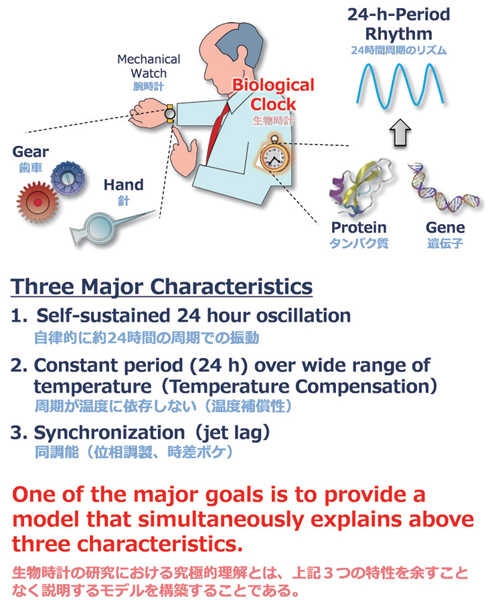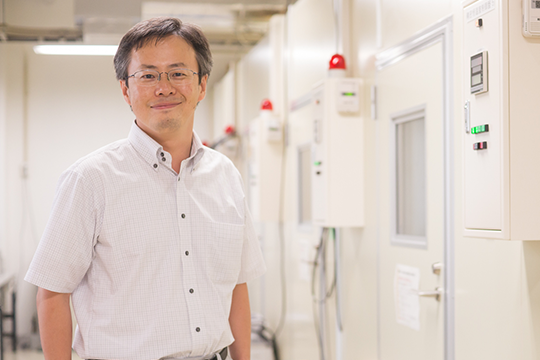Research Theme
Biological Rhythm & Dynamics, through Chemistry
Keywords
Circadian Clock, Cyanobacteria, Temperature Compensation
Circadian (approximately 24 h) clocks are endogenous time-keeping systems encapsulated in living cells, enabling organisms to adapt to daily fluctuation of exogenous environments on the Ear th.These time-keeping systems, found ubiquitously from prokaryotes to eukaryotes, share the three characteristics. First, the circadian rhythmicity of the clocks persists even without any external cues (self-sustainability). Second, the period is little dependent on ambient temperature (temperature compensation). Third, the phase of the clock can be reset by external stimuli such as lightning, humidity, or temperature so as to be synchronized to the external phase (synchronization).
KaiC, a core protein of the circadian clock in cyanobacteria, undergoes rhythmic structural changes over approximately 24 h in the presence of KaiA and KaiB (Kai oscillator). This slow dynamics spanning a wide range of both temporal and spatial scales is not well understood, and is central to a fundamental question: What determines the temperature-compensated 24 h period?1) The Kai oscillator reconstitutable in vitro is advantageous for studying its dynamic structure through a complementary usage of both X-ray crystallography2)-4), 6), 7) and solution scattering5), its transient response and synchronization by using physicochemical techniques, and its molecular motion through a collaborative work with computational groups4). Our mission is to explore the frontier in molecular science of the cyanobacterial circadian clock from many perspectives.

Towards a Unified View of Temperature-compensated 24 h Period in Biological Clock System.
Selected Publications
-
S. Akiyama, “Structural and dynamic aspects of protein clocks: How can they be so slow and stable?” CMLS 69, 2147-2160 (2012).
-
Y. Furuike et al., “Regulation Mechanisms of the Dual ATPase in KaiC” PNAS 119, e2119627119 (2022).
-
Y. Furuike et al., “Elucidation of Master Allostery Essential for Circadian Clock Oscillation in Cyanobacteria” Sci. Adv. 8, eabm8990 (2022).
-
J. Abe et al., “Atomic-scale Origins of Slowness in the Cyanobacterial Circadian Clock” Science 349, 312-316 (2015).
-
Y. Furuike et al., “Cross-scale Analysis of Temperature Compensation in the Cyanobacterial Circadian Clock System” Commun. Phys. 5, 75 (2022).
-
Furuike et al., "Regulation Mechanisms of the Dual ATPase in KaiC" PNAS 119, e2119627119 (2022).
-
Mukaiyama et al., "Highly sensitive tryptophan fluorescence probe for detecting rhythmic conformational changes of KaiC in the cyanobacterial circadian clock system" Biochem. J. 479, 1505-1515 (2022).



